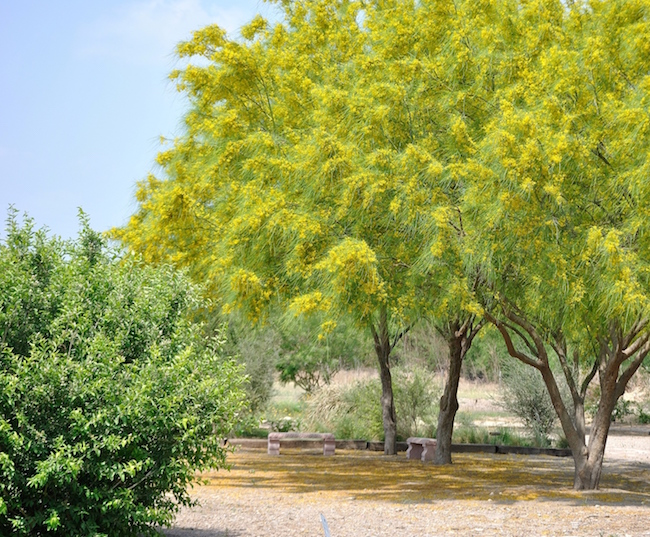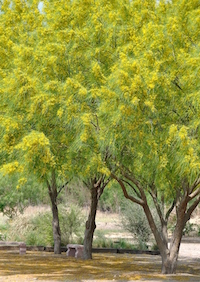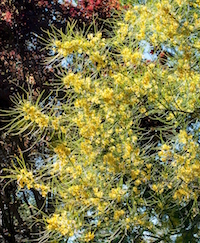I’ll never forget that rare cold morning at the National Butterfly Center in Mission, Texas. Monarchs and queen butterflies — cousin butterflies — were roosting in the retama trees waiting for the sun to warm them for flight. I had already fallen in love with the trees’ flashy display of thousands of yellow blooms, but also the green bark that seemed so prevalent.
Retama means “broom” in Spanish, but the green bark gives it another common name: Mexican paloverde, or green tree. I love both names, but officially its name is “Jerusalem thorn.” It has nothing to do with Israel, and the thorns in the tree are not a reference to Christ or the Crucifixion. According to the University of Texas at Austin’s Lady Bird Johnson Wildflower Center, the name comes from a corruption of the Portuguese and Spanish word “girasol,” which means “turning to the sun.”
Like the Lady Bird Johnson Wildflower Center, I’ll use paloverde. The paloverde is known botanically as “Parkinsonia aculeata” and is native from central Texas, west to Arizona and south through Mexico, actually reaching South America. The U.S. Department of Agriculture map shows distribution and establishment throughout the South, including Georgia and South Carolina.
Historic Southern landscapes are rich with allées such as those picturesque, old plantations lined with a garden walk or avenue of stately live oaks. At the Coastal Georgia Botanical Gardens at the Historic Bamboo Farm in Savannah, Georgia, we have a crape myrtle allée, and at the National Butterfly Center, we had a paloverde allée. Both are rewarding in their performance and classic design.
Right now at the Coastal Botanical Gardens, our paloverde trees are putting on quite a show. They are completely covered in blossoms. The flowers have five yellow petals, but one petal has a honey gland and turns an orange-red, giving the blooms a distinctive bicolored look. It is doubtful that we will ever find butterflies roosting in the fall like I saw at the National Butterfly Center, but I can tell you that our paloverde blooms are swarming with pollinators of all types.
The paloverde is about as tough of a tree as you can grow. Should the drought be so severe that it defoliates the tree, the stems and bark take up the task of photosynthesis, hence the green bark and stems. This also happens when cold causes the leaves to fall. The paloverde is cold hardy in zones 8 and warmer. As a point of reference, they are growing in the Dallas-Fort Worth area and are part of the Texas A&M Earth-Kind Landscaping program.
The Coastal Botanical Gardens’ oldest specimen is planted in the Xeriscape Demonstration Garden and is probably the only place in the world where you can see the bright yellow flowers of a paloverde against a backdrop of red foliage from a ‘Bloodgood’ Japanese maple. We have also been planting some in the new Sun Garden.
Paloverde trees will reach around 15 feet in height, possibly 25 feet. They are graceful in their pendulous state, but do remember that they are armed with spines. Select a site that is well-drained and receives almost full sun. They do not require or want a rich, moist soil and are capable of surviving on 12 inches of rain a year. Luxuriant, moist soil can lead to rampant reseeding. It has not been a problem in Savannah. This is a fine tree for those in zones 8-11 who are looking for both drought and salt tolerance.
Follow me on Twitter: @CGBGgardenguru. Learn more about the University of Georgia Coastal Georgia Botanical Gardens at www.coastalgeorgiabg.org.









